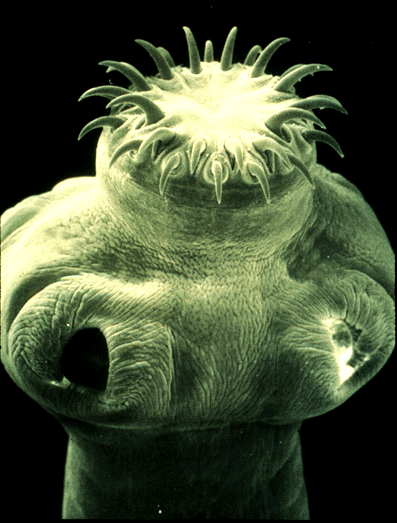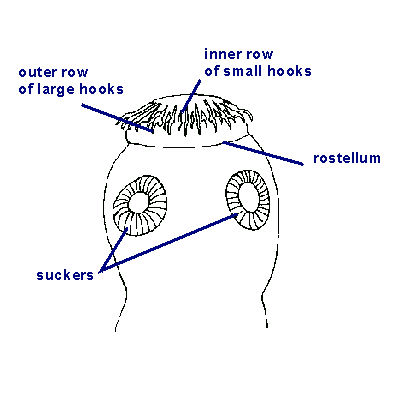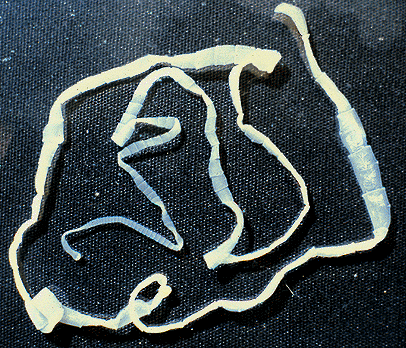Taenia pisiformis
Dog Tapeworm

Taenia pisiformis is one of the most common parasites of the dog (the other being Dipylidium caninum). It is found worldwide; more so in rural areas because it is passed on through small intermediate hosts (e.g. rabits, hares, etc.). If your dog does not hunt and eat these small creatures, it is not in any danger. This worm has been found, on rare occasions, to inhabit domestic cats, foxes, and other wild carnivores.
- Scolex
- Proglottid
-- Immature
-- Mature
-- Gravid
- Taxonomy
- Kingdom: Anamilia
-- Phylum: Platyhelminthes (flatworms)
---- Class: Cestoda (tapeworms)
------ Order: Cyclophyllidea
-------- Family: Taeniidae
---------- Genus: Taenia
------------ Species: pisiformis - [Top of Contents]
- Description
- The tapeworm body is made up of a scolex at the anterior of the organism and the strobila (body).
On the scolex of the parasite, there are four suckers, and two rings of hooks attached to a retractable restellum. They are used to help the worm lach itself to the wall of the intestine of the primary host.

The strobila is made up of segments called proglotidds. It is possible for a tapeworm to have thousands of proglottids. The immature proglotidds are located at the anterior of the worm. They are short and wide, and do not contain differentiated organs. The mature proglottids contain a complete reproductive system (male and female organs) along with an excretory and nervous system. The gravid proglottids, at the posterior, contain the eggs which will infect the new host. The size of the proglotidds increases as they move closer to the posterior.

- The gravid proglottids detach and are passed along with the dog's feces
- The proglottids rupture releasing thousands of eggs.
- The eggs are injested by the intermidiate host (e.g. rabbit).
- An oncosphere hatches from each of the eggs and penetrate the intestinal wall.
- The oncosphere then travels to the liver through the blood stream.
- In the liver the cysticercus developes (2-4 weeks).
- The cysticercus burrows out of the liver and attaches to the viscer in the peritoneal cavity
- The definitive host eats the intermidiate host.
- There, the cysticercus finds itself in the intestine of the the definitive host.
- The cysticercus attaches itself to the intestinal wall and begins to develop proglottids.
- Clinical Signs
- (Clinical signs are usually non-apparent)
- Canids
Rabits
- Digestive disturbances
- Severe liver damage
- Death
- Diagnostic Tests
- To confirm whether the canine is infected with Taenia Pisiformis, proglottids need to be found in fresh stool samples of the organism. However, the number of segements shed is no indication as to how many worms exist inside the intestine. The segments of the worms are not shed regularly.
- Treatment
- There are several drugs which could be given to the primary host (dog). To obtain them, a veterinarian should be consulted.
- Bunamindine hydrochloride
- Mebendazole
- Fenbendazole
- Niclosamide
- Praziquantel
- Epsiprantel
http://www.malteseonly.com/parasite.html
http://www.agric.gov.ab.ca/agdex/600/55-2.html
http://veterinary.ankara.edu.tr/~vatansev/Platyhelminths/Cestodes/Tpisifor.htm
http://cal.vet.upenn.edu/dxendopar/parasitepages/cestodes/t_pisiformis.html
http://www.dnr.state.mi.us/wildlife/Division/RoseLake/Publications/Disease_Manual/CYSTICER.html
http://biodidac.bio.uottawa.ca/Thumbnails/filedet.htm
http://bioweb.uwlax.edu/zoolab/Table_of_Contents/Lab-04/
http://www.science.lander.edu/rsfox/taenia.html
http://www.biosci.ohio-state.edu/~parasite/pisiformis.html
http://www.biology.ualberta.ca/courses.hp/zool352/
http://www.britanica.com/bcom/eb/article/0/
This page was constructed by Jennifer Han for Honors Biology,
04-24-00.
I take no credit for any of the images. If you would like credit please e-mail me:
[email protected]